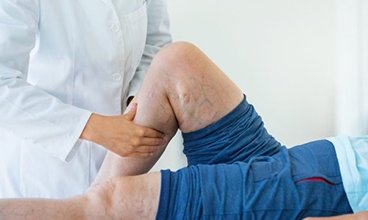
Have concerns about your vascular health? Experiencing what may be signs of vascular disease or conditions?
Don’t suffer alone. At the Vascular Institute, we specialize in helping our patients understand their symptoms, offering expert diagnosis and specialized treatments performed by our renowned vascular surgeon.
Get the help you need and the relief you deserve today. Many of our patients experience relief for the first time in decades after being treated.
Let us help you take back control of your health and quality of life.
Contact EVI Today
Specializing in the vascular system, a vascular surgeon provides both surgical and non-invasive non-surgical treatments for those conditions affecting the blood vessels. Necessary for the efficient transport of oxygen, hormones, nutrients and more, optimal blood vessel health and function help us lead happy healthy lives.
When things go wrong, it can spell trouble, with symptoms ranging from minor irritation to severe life-threatening conditions.
Known for world-class medical treatment, the Encino Vascular Institute provides North Hollywood area residents with compassionate care and innovative solutions that help patients restore their quality of life.
Do You Treat Varicose Veins in North Hollywood, CA?
Have you noticed that the veins in your legs or other areas appear to bulge out from the skin? Are they blue or purple in color? Do they seem to snake around under your skin like a road on a map?
If so, you may have varicose veins. Caused by faulty or damaged valves within your veins, these valves prevent proper circulation of blood as it returns back to your heart. The result is a swelling of veins, discoloration, pain and discomfort.
What Are the Common Symptoms of Varicose Veins?
Swelling, pain, an itching or burning sensation and/or cramping in the area.
Who is at Risk of Developing Varicose Veins?
Common risk factors include sitting or standing for long periods of time (usually for work), obesity, gender and family history.
What are The Risks if Not Treated
Those with less severe cases may experience minor discomfort without serious complications. However, those with more pronounced varicose veins or with disease progression may be at risk for blood clots, ulcers, infections due to open wounds, stroke and more. For concerns please call and schedule your consultation with Dr. Malekmehr or visit our vein clinic.
What Types of Treatment Options are Available?
Only you and your North Hollywood vascular surgeon can determine the appropriate treatment given your unique situation. However, common treatment options include both surgical and non-surgical interventions such as microphlebectomy, radiofrequency, endovenous sclerotherapy and vein stripping.
Peripheral Vascular Disease
What Is Peripheral Vascular Disease?
Peripheral vasculature refers to those blood vessels located outside of the heart and brain. Peripheral Vascular Disease (PVD) and Peripheral Artery Disease (PAD) are vascular conditions that affect the ability of peripheral veins and arteries to effectively transport blood. The condition often causes the narrowing, partial or full blockage of blood flow.
What are the Symptoms of PVD?
The symptoms of PVD can vary greatly depending on the severity of the condition, environmental or physiological triggers and underlying causes. Some common symptoms may include a sensation of itching or burning, usually in the lower extremities such as arms or legs. Ulcers or wounds may also develop and have difficulty healing. Other symptoms may present as reduced hair growth on legs, arms, hands or feet.
What are the Risk Factors for Developing PVD or PAD?
The risk of developing PAD or PVD is increased with diabetes, high cholesterol (clogged arteries), smoking, drug use and cardiovascular disease. Other types of PVD may be brought on situationally by operating vibrating machinery, cold temperatures and/or emotional stress such as anxiety, depression or bouts of sadness.
What Are the Risks Associated with PVD and PAD?
Peripheral vascular disease and peripheral artery disease can result in serious complications up to and including death. Complications if left untreated may include the development of wounds that have trouble healing, pain, blood clots, stroke, heart attack and erectile dysfunction.
What Treatment Options are Available for PVD and PAD?
Moderate to severe cases often require medical intervention. Treatments options sometimes include an atherectomy, angioplasty or stent placements. For mild or less severe cases, the disease and symptoms may be managed with lifestyle changes such as diet and exercise.
Thoracic Outlet Syndrome
What is Thoracic Outlet Syndrome?
Thoracic Outlet Syndrome (TOS) is a medical condition resulting in the compression of the nerves and blood vessels that run along and through tissues of the upper chest and neck.
What Types of Thoracic Outlet Syndrome are There?
There are two main types of TOS: venous, impacting the veins, and arterial, affecting the arteries of the vascular system.
What are the Symptoms of TOS?
Those with TOS may experience numbness, weakness, chronic fatigue, and swelling or tingling of the arms, hands or neck. Patients may also experience atrophy of any musculature impacted by nerve or blood vessel compression.
What are the Risk Factors for Developing TOS?
Those most at risk for developing TOS include bodybuilders, workers whose job involves repetitious overhead movements, those with poor posture, and pregnancy.
What Are the Potential Complications if Not Treated?
Failure to treat TOS could result in a frequency and/or increase of symptoms as well as further nerve or vessel damage, potentially leading to reduced mobility or other complications.
What are the Treatment Options for TOS?
Treatment options may include nerve block injections, surgery, or physical therapy.
Get Help from a Leading Varicose Vein Specialist & Vascular Surgeon in North Hollywood, CA
Call or message today to set up an appointment.